Tips for Hunting the Five Phases of the Deer Rut
Increase your odds of tagging a mature buck with these tactics for each phase of the rut.
It’s finally here, like Christmas for adults, but it arrives a month early and lasts for longer than a single day. It’s the rut.
We’re here to help you break down the rut and how to hunt it from start to finish. The rut certainly varies from state to state and hits at very different times in Illinois than it does in Mississippi, but segmenting it into multiple different time frames, or “phases” as the Drurys have coined, will help you become more successful.
Note that in this blog we focus on 2019 rut predictions for the majority of states, but in some states (particularly in the South) the rut will certainly come later in the season.
Rut definition: The rut is simply the deer breeding season. As daylight shortens throughout the end of summer and into autumn, bucks’ testosterone levels rise, eventually peaking in harmony with the same rise of estrus in does. These hormonal triggers cause a vast increase in deer movement—especially with mature bucks, which during this period become far less cautious during the short breeding season, making it an optimal time to be in a tree stand! These changes in daylight bring the absolute best time to be deer hunting to folks across the country—and it has arrived for 2019!
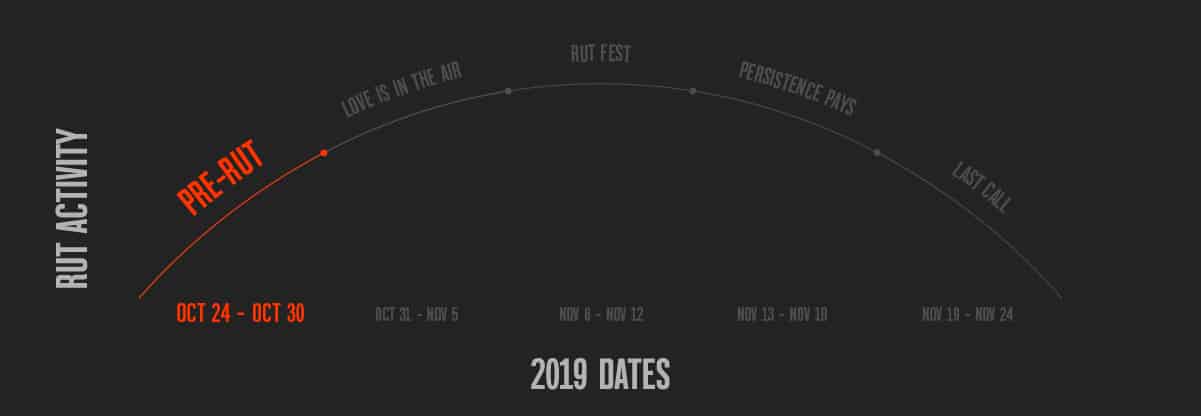
Pre-Rut
Dates: October 24th – October 30th
Author’s take: With the new moon falling on October 27th, these days should see great morning movement as well as earlier movement in the afternoons. I’d certainly be in the woods the last five days of October, especially if you have slightly below-average temperatures in your area.
Like anything with whitetails, the start of the rut is not something you can easily put your finger on, but you certainly know it when you see it. Young bucks are often cruising, does are a bit more on edge and mature bucks will start to move in daylight.
Scrapes are hit often. Don’t hesitate to hunt them or hang cameras on them. Bucks will be traveling outside their home range, so any chance to get photos of an array of different bucks is a win—not only for this year but obtaining data for years to come.
Your grunt tube and rattling antlers quickly become two of the most important pieces of gear in your pack. The time is now: start making some noise in the woods. Calling to visible deer is one of my favorite things to do all year, be it pulling out the grunt tube or rattling antlers (depending on the situation). Lastly, think food: where you find does, you will find what you are looking for. Using onX Hunt, the top-rated app for hunting deer, you can create custom waypoints to track these favored locations.
We asked Mark Drury of Drury Outdoors for his opinion on the Pre-Rut window: “Mark, you’ve said this is one of your favorite and most successful times to hunt. Given this is typically when you start calling can you share some insights on how you call during this phase?”
Mark’s response: “I’m really lower rung on calling. I like to start, low, slow and soft. In this phase, you’re dealing with still, calm mornings and evenings, so sound travels quite well. Also, I avoid blind calling and focus only on deer I can see or when I’ve got a good position where a deer can’t come downwind of me. I tend to reserve calling for the right moment to avoid getting busted by a non-target buck. Soft tending grunts are my go-to during this time.”
High-level takeaways:
- Begin calling
- Focus on scrapes
- Keep an eye on doe-attracting food sources
- Don’t forget about pinch points between food sources
- Shift trail cameras to scrapes and high traffic areas
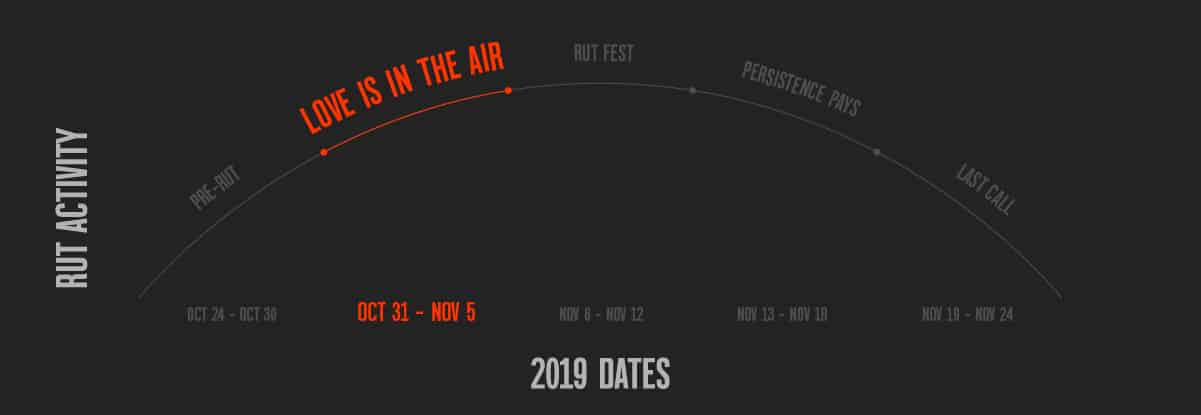
Love Is in the Air
Dates: October 31 – November 5
Author’s take: If you only have five days of time off and experiencing the most active deer movement of the year is as important as tagging mature deer, I’d start on the fourth. Head to deer camp on Friday the first and get ready to sit in a tree for ten hours a day for the next nine days. Bucks will be running rampant.
The first does are starting to come into estrus. Be sure to get in early—well before shooting time—and sit all day if you can. If you’re sitting on an edge or food source and it slows dramatically, think about sneaking into or hanging a tree stand on the downwind side of a doe bedding area. Now is the time to get aggressive; a common mistake many hunters make this time of year is playing it too cautious.
Scrapes are still very active and it’s well worth staying on the grunt tube and antlers or even a doe bleat, but be aware and do not over call, especially on public land. Try to check cameras on each walk in or out, as this intel is extremely valuable right now. Bucks are traveling further during this timeframe than any other time of year; in fact a Penn State study found they expanded their home range by three times on average—so you never know who might show up.
For “Love is in the Air,” we asked Mark Drury: “If you could only focus on one of the following during this period, which would it be: scrapes, doe bedding, food sources or something else?”
Mark said, “I’d still focus on food. The bucks are still looking for does, and the best place to find does is in and around food sources, which are often near doe bedding areas. I’m really focusing in on ‘doe holes.’ Suddenly those tend to become buck magnets.”
High-level takeaways:
- Get aggressive
- Check trail cameras often
- Focus on food in close proximity to doe bedding
- Be in early, and don’t be afraid to change it up midday
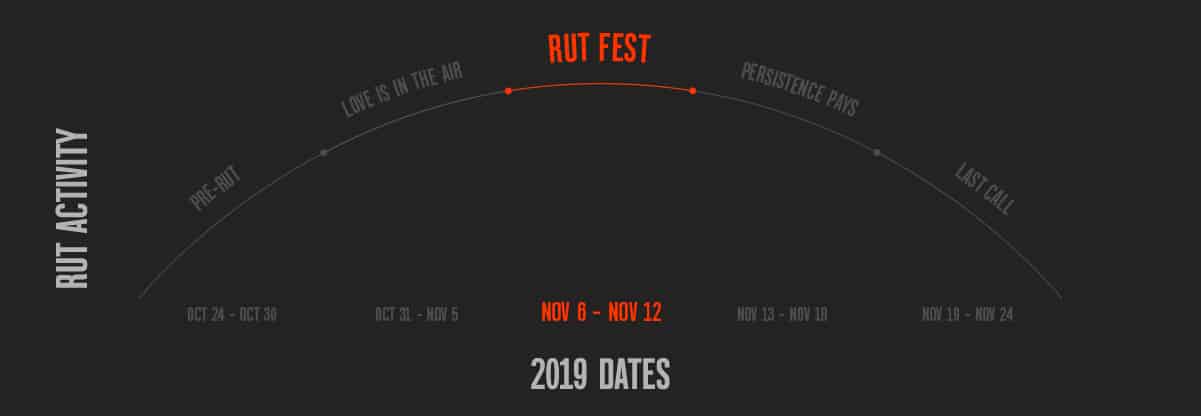
Rut Fest
Dates: November 6 – November 12
Author’s take: With the moon building into full on the 12th, these will be the best days of the year. Midday movement begins to increase, especially amongst mature bucks. In my experience, I typically notice things slowing down and moving toward lockdown beginning about November 10th, but this week is your best chance all year at a mature deer.
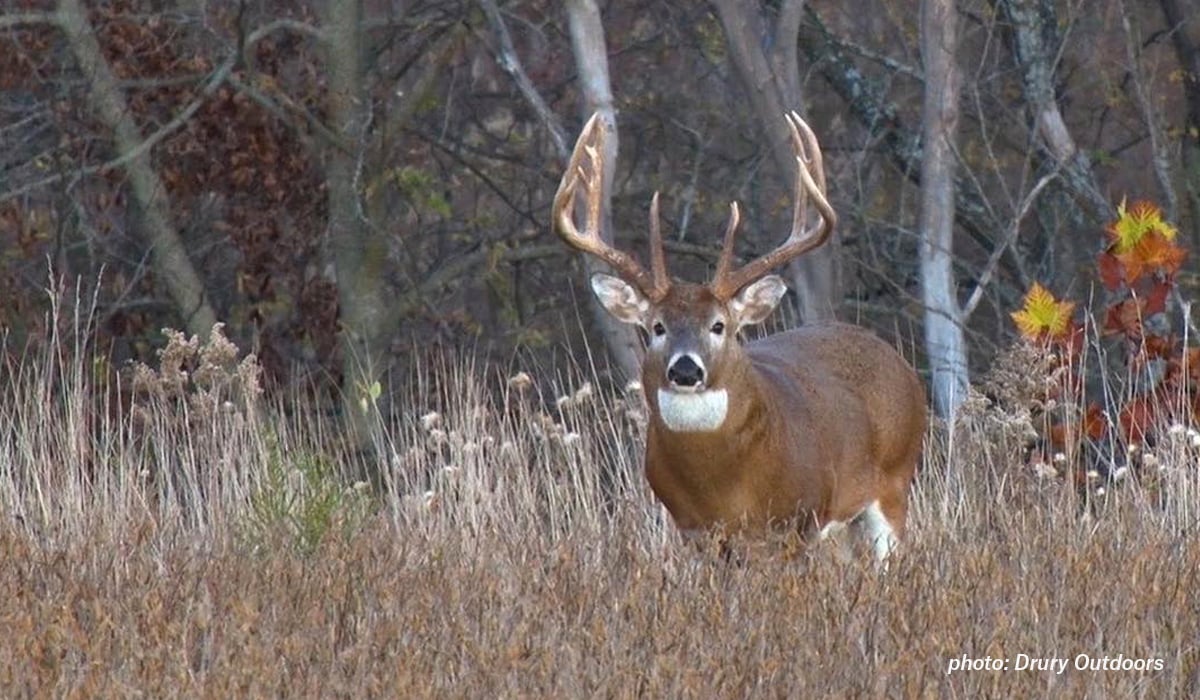
If you have vacation or sick days (or even if you don’t) give your boss a good story and get to your favorite tree stand. Take a page out of Sam Soholt’s book and pack some pizza rolls or biscuits and gravy in your YETI. More than likely it’s going to be cold; bring extra layers and sit through the elements all day. Hunt based on the data your trail cameras have produced in the last week. Pinch points, fence lines, field edges and other funneling spots are great places to intercept cruising bucks. The best days of the year are numbered and they are now!
High-level takeaways:
- Sit all day
- Hunt based on trail camera data
- Try a decoy and call strategically
- Focus on pinch points, edges and funnels
- You can’t be in the tree enough during these days—it’s that simple
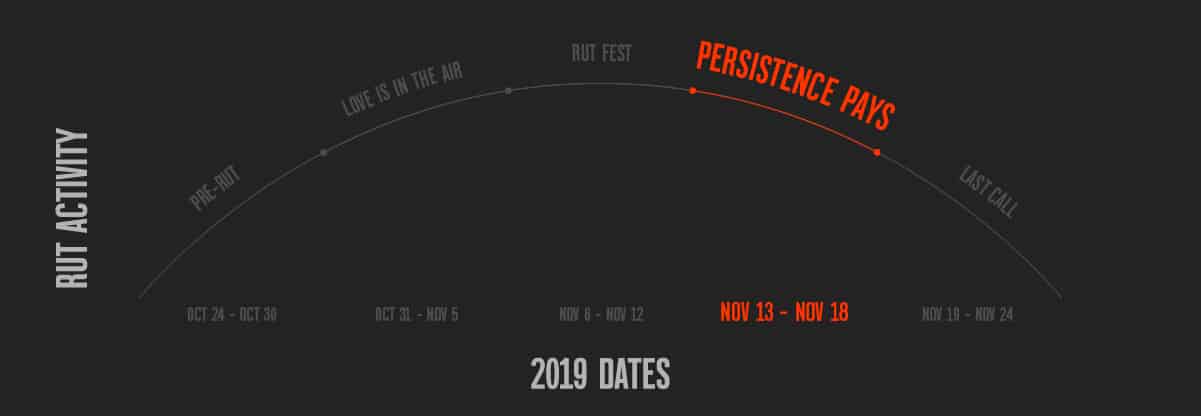
Persistence Pays
Dates: November 13 – November 18
Author’s take: In my experience, these days have been very hit-or-miss, and it really does become a “light switch” event. Midday is going to be key; if you have a few days you can afford to take off, I’d be looking at the 13th, 14th and 15th. If you put in the time, this can still be a great time to tag a mature deer.
You knew the days were numbered and suddenly we are on the backside of the bell curve. When does come into estrus and are ready to breed they typically bed down, often in obscure locations. Bucks will sit on or tend a doe for hours until the time has come to breed. One indicator of this is seeing “orphaned” fawns wandering around with no mature doe; that sight often signifies they are being tended by a buck and in lockdown. Movement is often sporadic and you never know when the light switch can flip back on. Stay at it; good things will happen.
Consider hunting a water source if you can; mature bucks that have been frantically seeking does will need to find water. A shift in focus to midday also becomes a great strategy; from 9AM till 4PM is a great time to be in tree stands. Lastly, get back into those bedding areas; get in quiet and make sure the wind is right, as these areas will be scent-checked by mature bucks.
We asked Mark Drury: “When hunting this phase, you mention you have found that deer seem to bed in strange places, and your best movement comes from 9-11AM and then 1-4PM. In your experience what stand types have been your best: near doe bedding, in thick cover, or food plots?”
Here’s Mark’s take: “I like to get back into in thick cover and find them in their bedroom, rather than transitional areas. These are normally sanctuary areas I won’t typically go into otherwise, but this time of the season is the exception. We struggled with this for years, but we finally figured it out.”
High-level takeaways:
- Stay aggressive
- All-day sits, shifting focus to midday
- Focus on bedding and potentially sit water
- Might only see a deer or two, but that’s all it takes
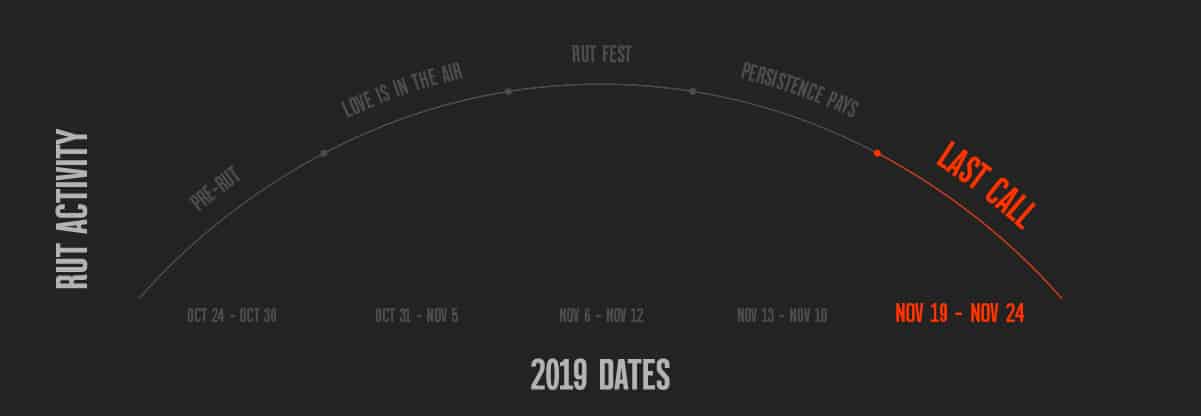
Last Call
Dates: November 19th – November 24th
Author’s Take: At this point mature bucks are still searching for late-estrus does but are a bit more wise in expending the little energy they have left. The moon is fading fast these dates, and I would focus on getting in early and hunting the mornings through midday on the 21st – 24th.
These hunts can be long, cold and downright tough. But bucks will still be in search of the last estrus does. As the bell curve suggests, movement tapers off quickly at this point. This is when midday can really be productive, and late in the rut it seems the bucks that are on their feet are often mature deer. I know we’ve harped on them this entire article, but with good reason—sitting downwind of doe bedding areas is a great strategy right now.
Look back into your trail camera archives and see where you had pictures of bucks last year at this time, then compare what you’ve gathered the last couple weeks with last year’s archives. Deer are creatures of habit and will likely be on a similar pattern as in years past, so use this data to your advantage. This is a true test of your grit and how badly you want to tag out. You won’t have that “Christmas morning feeling” the rut brings for another 340 or so days—so soak it up and get to a tree.
We asked Mark Drury for his tips on the “Last Call” window: “You speak to hunting funnels and pinch points when talking about finding success in this phase. Can you elaborate on the specifics of these focal points? Catching them from bedding on wooded ridges to ag fields, between thermal cover and food plots, using water features, etc.?”
Here’s Mark’s take: “The trick during this phase is trying to catch them traveling near the bedroom. That movement is more often during midday. In fact, by 3-4PM the movement is pretty much done.”
High-level takeaways:
- Grind it out
- Be there midday
- Hunt past trail camera data
- Hunt heavy traffic places—bedding, funnels, best food available
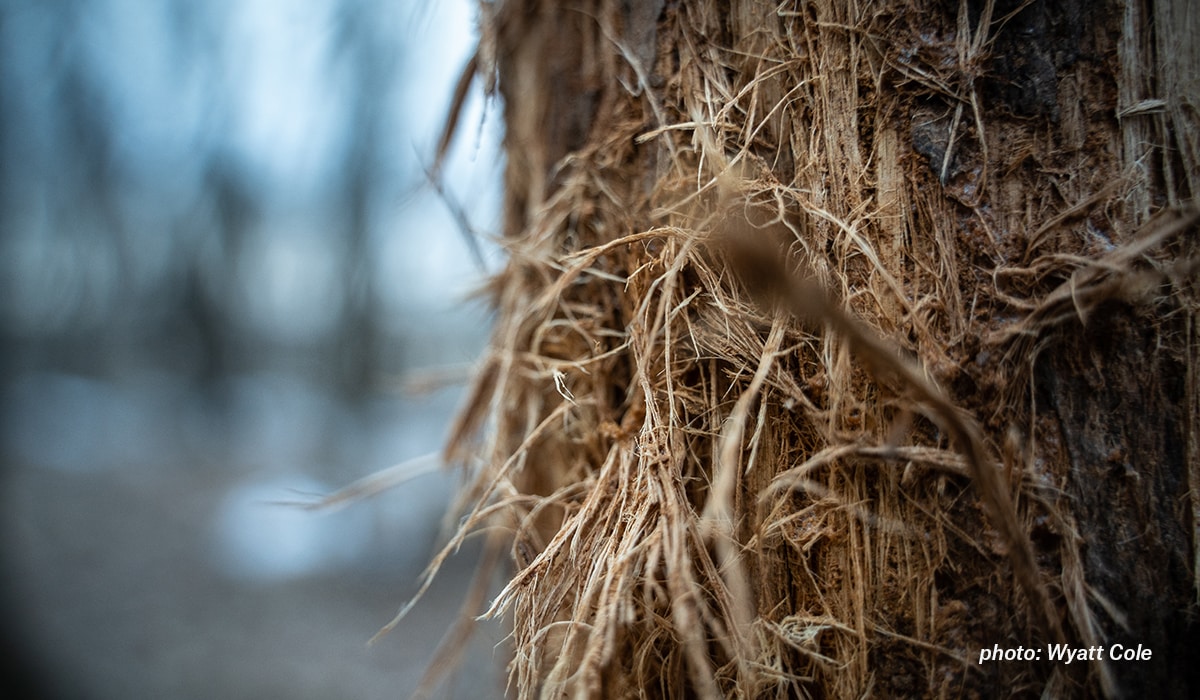
Check out the Deer Cast App for the most accurate intel for your area. Mark, Terry and the gang have gathered decades of data to give you insights on when the best times are to be in a tree— all based on your location and peak rut date you set in the app.
Some thoughts on hunting moon phases: It certainly excites me where the new and full moon fall for November of 2019 in regards to my stomping grounds in the upper Midwest. I often find that around new moons, movement is really good early and will typically stay steady until mid-morning. In the evenings, I’ve observed a bit earlier movement as well. The full moon falling that second full week of November aligns perfectly with the emphasis on sitting midday at and after the peak of the rut. During full moons, it is nearly without fail that my most frequent mature buck sightings/encounters are between 9AM and 1PM.
Weather: Yet another factor totally out of our control. You’re just going to have to play the hand that is dealt. Generally, average or slightly below average temps are ideal. Regardless of what Mother Nature throws at you, you’re not going to be successful if you’re not out there.
Looking for 2020 rut predictions?